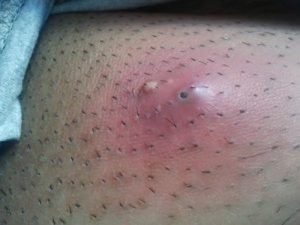Wheatgrass extract reduces pain of abscess drainage and heals rapidly if applied before the procedure. (Fig. 1.)
A middle-aged man sitting on the edge of his chair in the waiting-room was in severe pain due to a large, “pointing” abscess on his buttock - like the one in the photograph. He had been in pain for two weeks that could have beenn easily avoided by a quick stab with a sharp scalpel.

"Pointing" means the abscess is ready to be opened and drained of the pus inside. Without this procedure, the patient would suffer severe pain until the abscess burst of its own accord - which might take a painful week or two. In the photograph, the abscess is “pointing” - i.e. it's about to burst open. Quick drainage with a sharp knife is essential, and is easy to do using a sharp scalpel. (Photo: Courtesy of Amrith Raj. Wikipedia)
The small dark spot near the top of the abscess is a “plug” of keratin that is preventing the abscess from bursting open to discharge the pus. (Because there is no blood supply inside an abscess, antibiotics are of little use. Incision and drainage is the way to proceed.) Wheatgrass extract applied to the abscess can do much to reduce swelling, ease pain and accelerate healing of the wound.
Drainage can be a painful procedure, but application of wheatgrass extract over the swollen area before incision can significantly reduce pain. Also, the wound will shrink rapidly and heal quicker so "packing” making gauze unnecessary. Instead, just apply a firm dressing over the area and cleanse and dry the wound daily.